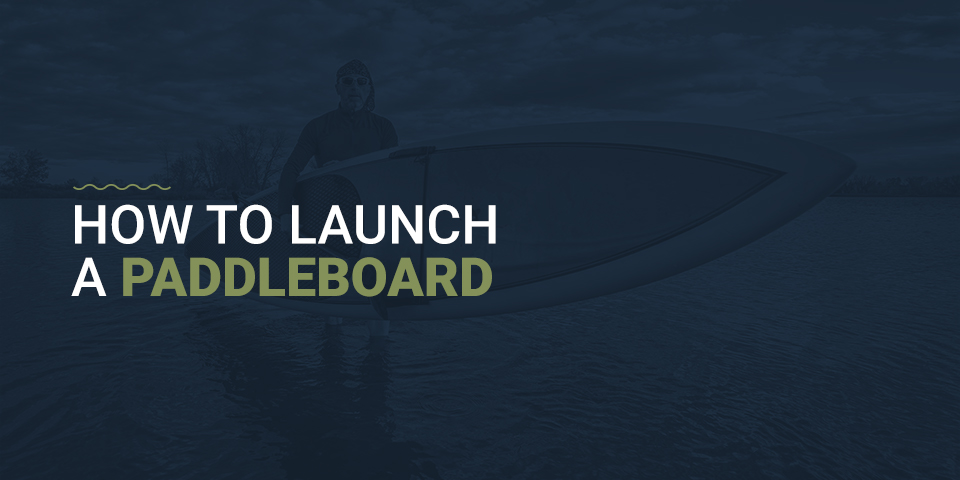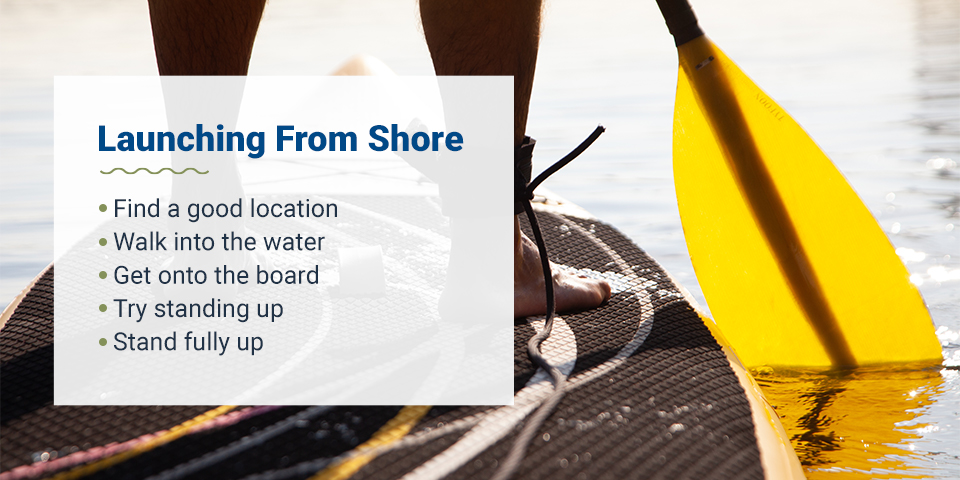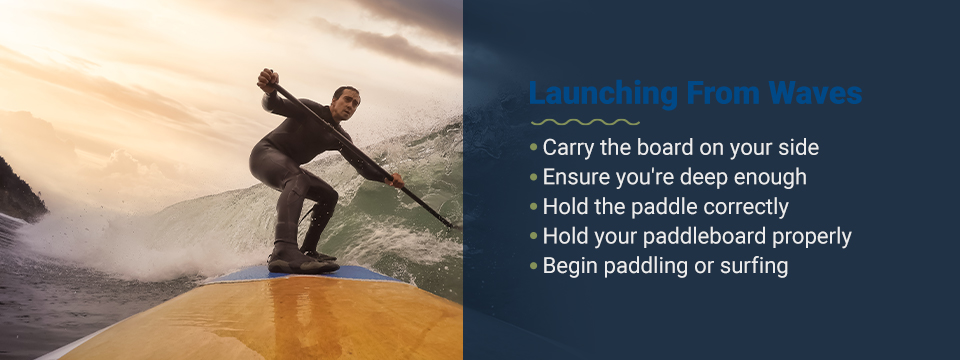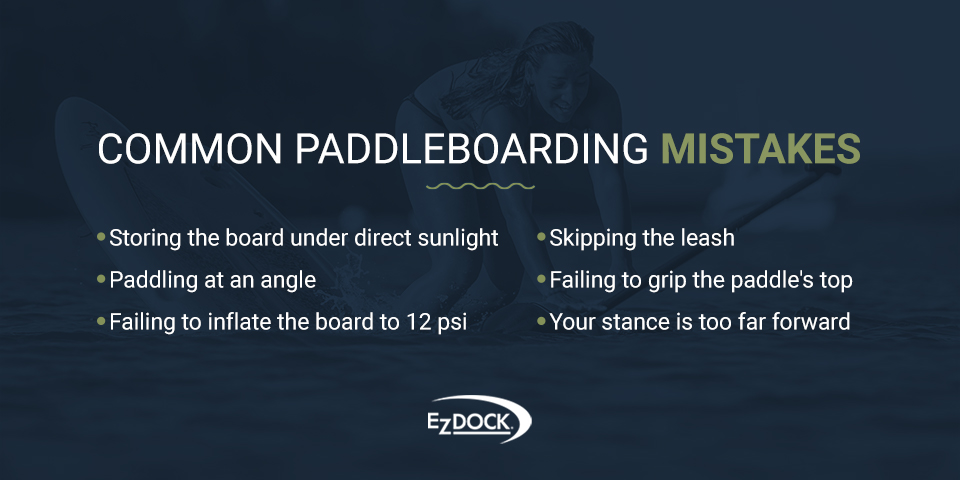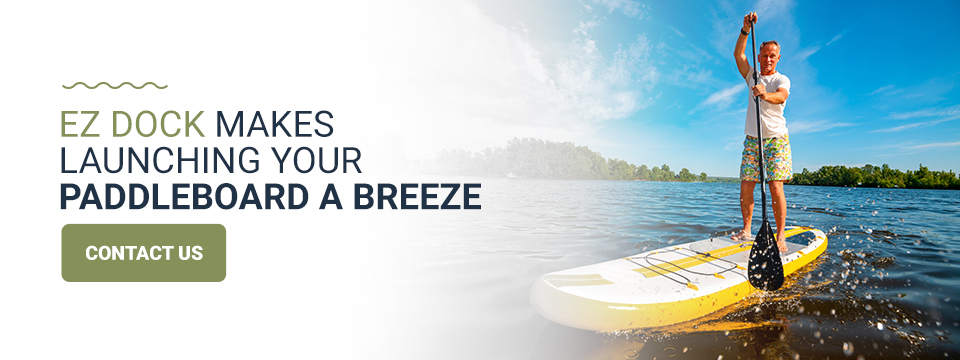Filters
How to Launch a Paddleboard
Stand-up paddleboarding is a great way to have fun on the water while simultaneously getting a full-body workout. But if you’re trying this unique sport for the first time, you’ll want to familiarize yourself with fundamental techniques and equipment. In this article, we’ll cover how to prepare for your paddleboarding adventure and how to launch it from a shore, a dock and waves.
Read the full article or jump to a specific section:
- Preparing for Launch
- Launching from Shore
- Launching from a Dock
- Launching from Waves
- How to Stay Balanced
- Common Paddleboarding Mistakes
Preparing for Launch
Before you depart for your paddleboard adventure, don’t forget to look up the weather forecast for the place where you’ll be paddleboarding. If you’re planning to paddleboard in the ocean, check the currents and tide. Charts and maps can show you these, or you can rely on apps that provide up-to-the-minute information.
Though paddleboarding doesn’t require much equipment — only a paddle and a board — you should remember to bring along the following:
- Bag or carry handles
- Pump
- Leash
- Waterproof bag
- Paddle holders
- Sunglasses and sunscreen
- Additional fins
- Swimwear or wetsuit
- Life vest
- Whistle
Once you’ve reached the water where you plan to launch your SUP board, make sure you do the following beforehand.
- Find a safe location to launch your board: This spot should be a place where you won’t interrupt anybody else’s enjoyment of the water and they won’t interfere with your launch.
- Take your time: Don’t rush when launching a paddleboard. Balancing takes practice, and strong winds or waves can make it more challenging.
- Confirm you have everything you need: You won’t want to realize you’ve left something behind after you’re out on the water.
- Hold onto your paddle: Otherwise, it could float away. We understand it’s demanding to focus on so much initially, and letting your paddle float away is easy to do. To prevent this from happening, consider getting a paddle holder.
Once you’ve done all the above, you’re ready to launch.
Launching From Shore
There are various ways to launch a paddleboard, but casting off from shore is probably the most common. It may feel a bit tricky at first, but you’ll get a feel for it in no time. To help your SUP launch from shore go smoothly every time, follow these steps.
- Find a good location: If you’re also planning to surf, this spot must be a beach. If it’s a lake or river, you need to find a quiet place to walk in. Use caution when entering the water as the bottom can suddenly drop away. The ideal place to launch your paddleboard is a calm, flat area with no other people nearby to interfere. If you’re using a leash, don’t forget to attach it. Pick the direction you want to go and point your board toward it.
- Walk into the water: Stop when the water gets up to your knees, as this is usually deep enough. However, you must be sufficiently far out that your board’s fin won’t scrape against the bottom once you stand on it. Most boards require roughly 12 inches of clearance. Hold your paddleboard to one side as you face in the direction you want to go, then place the paddle alongside it. It doesn’t matter which way the paddle faces, though many paddleboarders prefer the blade to point toward the board’s front. Place the paddle’s grip on the board’s edge with your blade resting on the water. You ideally want the paddle on the side that is opposite to the one you’re standing on.
- Get onto the board: Keep one hand on the paddle to ensure it won’t fall off. Grip the board’s rails. Place a knee on your board, so it remains stable with your hands on the rails. Next, raise your other knee until you’re kneeling on your paddleboard. At this point, you are hopefully facing the correct direction. You must aim for the board’s center, so move your weight slowly until you feel balanced properly. If it’s your first time paddleboarding, we recommend taking a few strokes on each side of the board from your knees to get a feel for it.
- Try standing up: Once the board is stable, attempt to stand. Do this step slowly until you feel entirely comfortable with it. Put your hands on the rails once again, which will help stabilize your board. Your feet should be shoulder-width apart from one another, so move one foot at a time into position. While doing this, keep your hand on the rails to maintain balance.
- Stand fully up: Lean forward, lifting your buttocks off your feet. You should now be in a position where you look like you’re about to crawl on your hands and knees. With your hands still on the paddle in front of you, bring each knee up to your chest in a smooth motion, so you’re squatting on the balls of your feet. From this position, push yourself up as if you were lifting a heavy object. Remember to keep your back straight and your feet flat and shoulder-width apart.
Launching From a Dock
For those new to the sport, launching from a dock can be daunting, but you should have no problem if you follow the steps below.
- Look for potential obstacles: Check for obstacles like boats, cleats, bird poop and dock railings. You’ll want to ensure you won’t encounter any barriers or impediments when setting your paddleboard to sail.
- Stay low when getting on or off: As you know, when you lower your body’s center of gravity, you can balance yourself much more easily.
- Be cautious when launching: You should be on your knees when paddling to or from the dock to avoid any incidents or mishaps while you’re standing. You could encounter unpredictability after releasing your paddleboard from the dock. Once you’ve achieved some distance from the dock, you can stand.
Launching From Waves
When launching your paddleboard in waves, be aware that you don’t need to attach your leash in advance. Wait until you get close to the water. If you connect it too early, it might cause you to trip over your board while you’re walking on the beach. You should also handle your leash carefully because it can snap easily. Before you hit the ocean, make a plan. Pick a good spot to launch and head directly to it. Some other valuable tips include the following.
- Carry the board on your side: Don’t waste your energy and time wading along the shore — walk directly to the place where you want to launch your paddleboard. As you do so, hold your board to one side, which will make it easier to carry. Many paddleboarders prefer to carry their boards on their dominant side, but after you’ve been paddleboarding for some time, you’ll know which side feels more natural to you. Holding it on the wrong side may cause you to reposition yourself, and you may risk getting run over by your board when you put it down.
- Ensure you’re deep enough: You want to ensure your board is in sufficiently deep water, so the fins won’t scratch the ocean’s bottom.
- Hold the paddle correctly: When you walk into the ocean, be sure you’re holding the paddle properly so you won’t get hurt when waves hit. The correct method for holding when you walk is to carry it with the blade facing the beach and the handle facing the sea. If you’re not holding the paddle correctly, a wave could lift it and tear it from your hands or cause it to pop up and hit you in the face. Use your front hand to hold the paddle’s top in the center line, and your back hand to hold your paddle on your board’s tail.
- Hold your paddleboard properly: In shallow water, make sure you’re holding your board at the correct angle. Your board should point into the water directly at a 90-degree angle, which will let the board cut through waves. Otherwise, the waves may push you back to the shore. When a wave comes, lift the board’s nose by pushing its tail down using your back hand. That way, the board’s nose won’t get hit by whitewater. Holding your board at 90 degrees might not come naturally, so practice this until you feel comfortable and in complete control of your board before heading to deeper waters. There’s a chance you’ll lose control of the board, but if this happens, reposition yourself and start over. Don’t attempt to fight with the whitewater while holding your board improperly. When a wave is coming, you should also be aware of where your fingers are, as they could get sprained or even broken when holding the board.
- Begin paddling or surfing: You need to consider various factors when deciding when to climb up on the paddleboard. The ideal depth is when the water is roughly waist-deep. Don’t ever set off when waves are coming in groups — instead, stay at your current depth and wait for the right moment. Conserve your energy and wait for a large enough gap in the waves that allows you to get on your board and start paddling. When you walk out, if only a few waves are passing, you won’t have to deal with as many waves when making it to the starting point. When you finally climb on your board, paddle with all your might to make it through the waves as quickly as you can.
How to Stay Balanced
To remain balanced on your paddleboard, it is crucial to place your feet parallel to one another, in a hip-wide stance. Center your feet between the sides of your board. You should also:
- Slightly bend your knees.
- Straighten your back.
- Point your toes forward.
- Move your hips to shift your weight.
- Keep your head and shoulders upright.
- Look at the horizon, not your feet.
- Get on your knees for more stability if you feel like you’re losing your balance.
- Fall away from the board so you won’t get injured.
Common Paddleboarding Mistakes
You’ll want to avoid several practices when starting on a paddleboard. Perhaps the most common mistake is having your paddle’s blade face the wrong way. Bending the blade away from you will give you optimal speed and tracking. Other missteps to avoid include the following.
- Storing the board under direct sunlight: Whether your paddleboard is hard or inflatable, never keep it under direct sunlight for extended periods. The sun’s heat could cause a hard board to delaminate and damage the seams of an inflatable board. Sunlight can also cause your board’s color to fade.
- Paddling at an angle: While the stroke may seem simple, most beginners aren’t aware they’re not doing it correctly. The paddle should be perpendicular to the board when entering the water, not at an angle. With this technique, every stroke will provide you with more power.
- Failing to inflate the board to 12 psi: Fill inflatable boards to 12 psi. Anything lower will negatively affect your board’s performance and rigidity.
- Skipping the leash: Don’t paddleboard without a leash — it will keep your board near you if you fall off, meaning you won’t have to use extra energy swimming after it. If you fall while it’s windy or there’s a current, the board may sail away, leaving you unable to catch it. Also, if you’re surfing, the leash will keep your board from hitting others nearby.
- Failing to grip the paddle’s top: No matter which side you’re paddling on, you should grip the paddle’s top with your hand. It’s also more comfortable this way.
- Your stance is too far forward: Standing too far toward the front of the board is another typical mistake among paddleboard beginners. The closer you stand to the nose of your board, the more difficulty you’ll have trying to control it. Paddleboards usually have carry handles located at the deck pad’s center — this is roughly where you should be standing on your board.
EZ Dock Makes Launching Your Paddleboard a Breeze
EZ Dock is one of the world’s leading manufacturers of floating docks, and you can find our products all over, including at marinas, resorts, restaurants, government facilities, military installations and homes. If you’d like a high-quality dock to launch your paddleboard — or for any other water activity — we can help you. Reach out to us using our contact form.

